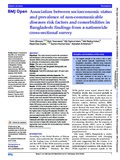| dc.contributor.author | Biswas, Tuhin | |
| dc.contributor.author | Townsend, Nick | |
| dc.contributor.author | Islam, Md Saimul | |
| dc.contributor.author | Islam, Md Rajibul | |
| dc.contributor.author | Gupta, Rajat Das | |
| dc.contributor.author | Das, Sumon Kumar | |
| dc.contributor.author | Mamun, Abdullah Al | |
| dc.date.accessioned | 2022-03-16T09:29:09Z | |
| dc.date.available | 2022-03-16T09:29:09Z | |
| dc.date.copyright | 2019 | |
| dc.date.issued | 2019-03-13 | |
| dc.identifier.citation | Biswas, T., Townsend, N., Islam, M. S., Islam, M. R., Das Gupta, R., Das, S. K., & Mamun, A. A. (2019). Association between socioeconomic status and prevalence of non-communicable diseases risk factors and comorbidities in Bangladesh: Findings from a nationwide cross-sectional survey. BMJ Open, 9(3) doi:10.1136/bmjopen-2018-025538 | en_US |
| dc.identifier.uri | http://hdl.handle.net/10361/16468 | |
| dc.description | This article was published in the BMJ Open [© Author(s) (or their employer(s)) 2019. Re-use permitted under CC BY-NC. No commercial re-use. See rights and permissions. Published by BMJ.] and the definite version is available at: http://dx.doi.org/10.1136/bmjopen-2018-025538 The Journal's website is at: https://bmjopen.bmj.com/content/9/3/e025538 | en_US |
| dc.description.abstract | Objectives This study aimed to examine the prevalence
and distribution in the comorbidity of non-communicable
diseases (NCDs) among the adult population in Bangladesh
by measures of socioeconomic status (SES).
Design This was a cross-sectional study.
Setting This study used Bangladesh Demographic and
Health Survey 2011 data.
Participants Total 8763 individuals aged ≥35 years were
included.
Primary and secondary outcome measures The
primary outcome measures were diabetes mellitus (DM),
hypertension (HTN) and overweight/obesity. The study
further assesses factors (in particular SES) associated with
these comorbidities (DM, HTN and overweight/obesity).
Results Of 8763 adults, 12% had DM, 27% HTN and 22%
were overweight/obese (body mass index ≥23 kg/m2
). Just
over 1% of the sample had all three conditions, 3% had
both DM and HTN, 3%DM and overweight/obesity and 7%
HTN and overweight/obesity. DM, HTN and overweight/
obesity were more prevalent those who had higher
education, were non-manual workers, were in the richer
to richest SES and lived in urban settings. Individuals in
higher SES groups were also more likely to suffer from
comorbidities. In the multivariable analysis, it was found
that individual belonging to the richest wealth quintile had
the highest odds of having HTN (adjusted OR (AOR) 1.49,
95% CI 1.29 to 1.72), DM (AOR 1.63, 95%CI 1.25 to 2.14)
and overweight/obesity (AOR 4.3, 95%CI 3.32 to 5.57).
Conclusions In contrast to more affluent countries,
individuals with NCDs risk factors and comorbidities are
more common in higher SES individuals. Public health
approaches must consider this social patterning in tackling
NCDs in the country. | en_US |
| dc.language.iso | en_US | en_US |
| dc.publisher | BMJ Open | en_US |
| dc.relation.uri | https://bmjopen.bmj.com/content/9/3/e025538 | |
| dc.subject | Bangladesh | en_US |
| dc.subject | Diabetes | en_US |
| dc.subject | Hypertension | en_US |
| dc.subject | Non-communicable disease | en_US |
| dc.subject | Overweight | en_US |
| dc.subject | Socioeconomic status | en_US |
| dc.title | Association between socioeconomic status and prevalence of non-communicable diseases risk factors and comorbidities in Bangladesh: Findings from a nationwide cross-sectional survey | en_US |
| dc.type | Journal Article | en_US |
| dc.description.version | Published | |
| dc.contributor.department | Brac James P. Grant School of Public Health | |
| dc.identifier.doi | http://dx.doi.org/10.1136/bmjopen-2018-025538 | |

